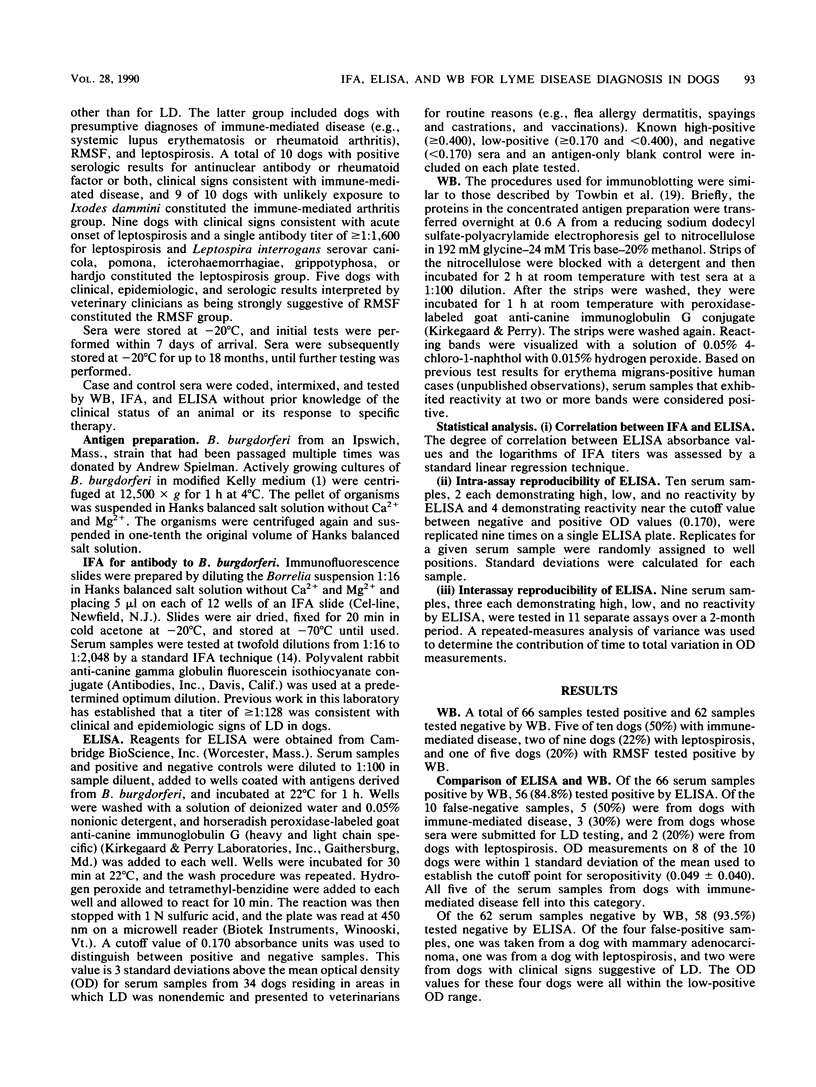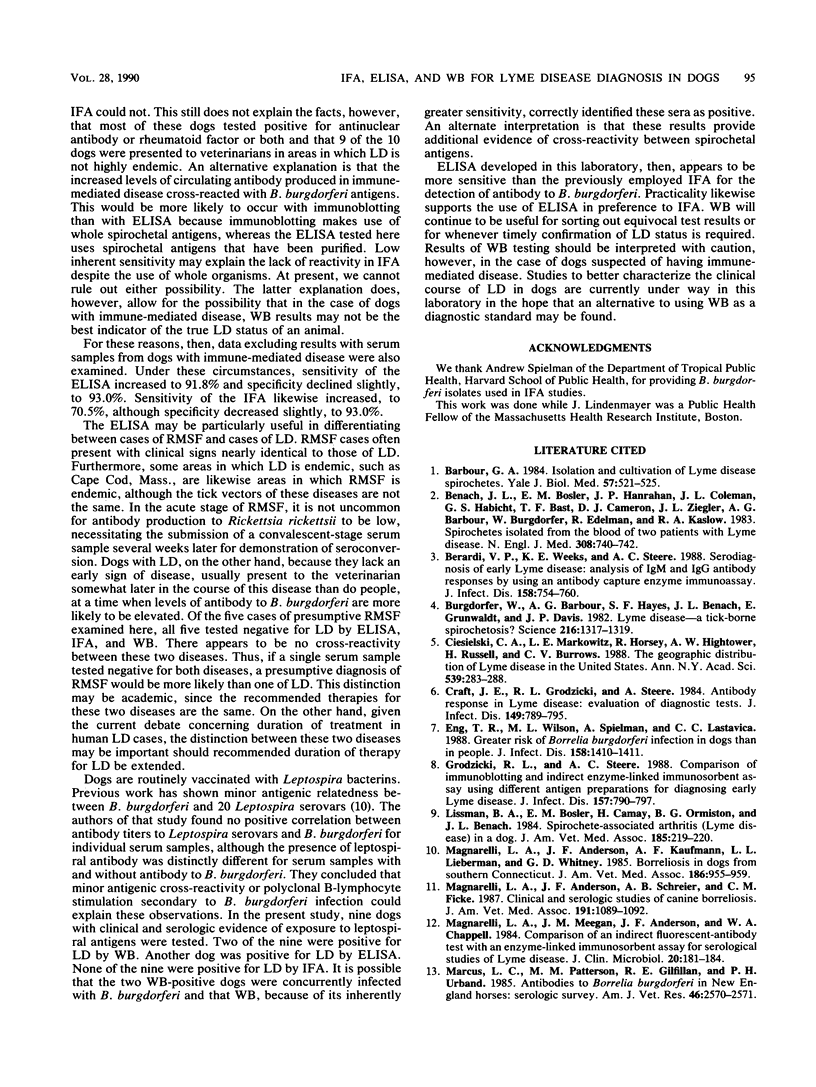Abstract
Enzyme-linked immunosorbent assay (ELISA), indirect immunofluorescent-antibody assay (IFA), and Western immunoblot were used to test serum samples from 128 dogs for the presence of antibody to Borrelia burgdorferi. Sera included 72 samples from dogs suspected of having Lyme disease, 32 samples from dogs residing in areas in which Lyme disease was not considered endemic, and 24 samples from dogs with clinical and serologic evidence of immune-mediated disease (n = 10), Rocky Mountain spotted fever (n = 5), or leptospirosis (n = 9). Results of Western immunoblotting were used as the standard against which performances of ELISA and IFA were measured. ELISA was significantly more sensitive than IFA (84.8 versus 66.7%), although both tests were equally specific (93.5%). Eight samples that were positive by Western immunoblot were simultaneously negative by ELISA and IFA. Of these eight, four were from dogs suspected of having immune-mediated disease, two were from dogs suspected of having leptospirosis, and two were from dogs suspected of having Lyme disease. These results may indicate that sera from dogs with immune-mediated disease, and to a lesser extent sera from those with leptospirosis, cross-react with B. burgdorferi antigens. Alternatively, Western immunoblot results may not truly reflect Lyme disease status, particularly in the case of dogs with immune-mediated diseases. At present, however, the use of Western immunoblotting as a diagnostic standard for dogs offers the best alternative to a clinical definition of disease.
Full text
PDF




Selected References
These references are in PubMed. This may not be the complete list of references from this article.
- Barbour A. G. Isolation and cultivation of Lyme disease spirochetes. Yale J Biol Med. 1984 Jul-Aug;57(4):521–525. [PMC free article] [PubMed] [Google Scholar]
- Benach J. L., Bosler E. M., Hanrahan J. P., Coleman J. L., Habicht G. S., Bast T. F., Cameron D. J., Ziegler J. L., Barbour A. G., Burgdorfer W. Spirochetes isolated from the blood of two patients with Lyme disease. N Engl J Med. 1983 Mar 31;308(13):740–742. doi: 10.1056/NEJM198303313081302. [DOI] [PubMed] [Google Scholar]
- Berardi V. P., Weeks K. E., Steere A. C. Serodiagnosis of early Lyme disease: analysis of IgM and IgG antibody responses by using an antibody-capture enzyme immunoassay. J Infect Dis. 1988 Oct;158(4):754–760. doi: 10.1093/infdis/158.4.754. [DOI] [PubMed] [Google Scholar]
- Burgdorfer W., Barbour A. G., Hayes S. F., Benach J. L., Grunwaldt E., Davis J. P. Lyme disease-a tick-borne spirochetosis? Science. 1982 Jun 18;216(4552):1317–1319. doi: 10.1126/science.7043737. [DOI] [PubMed] [Google Scholar]
- Ciesielski C. A., Markowitz L. E., Horsley R., Hightower A. W., Russell H., Broome C. V. The geographic distribution of Lyme disease in the United States. Ann N Y Acad Sci. 1988;539:283–288. doi: 10.1111/j.1749-6632.1988.tb31862.x. [DOI] [PubMed] [Google Scholar]
- Craft J. E., Grodzicki R. L., Steere A. C. Antibody response in Lyme disease: evaluation of diagnostic tests. J Infect Dis. 1984 May;149(5):789–795. doi: 10.1093/infdis/149.5.789. [DOI] [PubMed] [Google Scholar]
- Eng T. R., Wilson M. L., Spielman A., Lastavica C. C. Greater risk of Borrelia burgdorferi infection in dogs than in people. J Infect Dis. 1988 Dec;158(6):1410–1411. doi: 10.1093/infdis/158.6.1410. [DOI] [PubMed] [Google Scholar]
- Grodzicki R. L., Steere A. C. Comparison of immunoblotting and indirect enzyme-linked immunosorbent assay using different antigen preparations for diagnosing early Lyme disease. J Infect Dis. 1988 Apr;157(4):790–797. doi: 10.1093/infdis/157.4.790. [DOI] [PubMed] [Google Scholar]
- Lissman B. A., Bosler E. M., Camay H., Ormiston B. G., Benach J. L. Spirochete-associated arthritis (Lyme disease) in a dog. J Am Vet Med Assoc. 1984 Jul 15;185(2):219–220. [PubMed] [Google Scholar]
- Magnarelli L. A., Anderson J. F., Kaufmann A. F., Lieberman L. L., Whitney G. D. Borreliosis in dogs from southern Connecticut. J Am Vet Med Assoc. 1985 May 1;186(9):955–959. [PubMed] [Google Scholar]
- Magnarelli L. A., Anderson J. F., Schreier A. B., Ficke C. M. Clinical and serologic studies of canine borreliosis. J Am Vet Med Assoc. 1987 Nov 1;191(9):1089–1094. [PubMed] [Google Scholar]
- Magnarelli L. A., Meegan J. M., Anderson J. F., Chappell W. A. Comparison of an indirect fluorescent-antibody test with an enzyme-linked immunosorbent assay for serological studies of Lyme disease. J Clin Microbiol. 1984 Aug;20(2):181–184. doi: 10.1128/jcm.20.2.181-184.1984. [DOI] [PMC free article] [PubMed] [Google Scholar]
- Marcus L. C., Patterson M. M., Gilfillan R. E., Urband P. H. Antibodies to Borrelia burgdorferi in New England horses: serologic survey. Am J Vet Res. 1985 Dec;46(12):2570–2571. [PubMed] [Google Scholar]
- Russell H., Sampson J. S., Schmid G. P., Wilkinson H. W., Plikaytis B. Enzyme-linked immunosorbent assay and indirect immunofluorescence assay for Lyme disease. J Infect Dis. 1984 Mar;149(3):465–470. doi: 10.1093/infdis/149.3.465. [DOI] [PubMed] [Google Scholar]
- Schulze T. L., Bosler E. M., Shisler J. K., Ware I. C., Lakat M. F., Parkin W. E. Prevalence of canine Lyme disease from an endemic area as determined by serosurvey. Zentralbl Bakteriol Mikrobiol Hyg A. 1987 Feb;263(3):427–434. doi: 10.1016/s0176-6724(87)80104-9. [DOI] [PubMed] [Google Scholar]
- Steere A. C., Grodzicki R. L., Kornblatt A. N., Craft J. E., Barbour A. G., Burgdorfer W., Schmid G. P., Johnson E., Malawista S. E. The spirochetal etiology of Lyme disease. N Engl J Med. 1983 Mar 31;308(13):733–740. doi: 10.1056/NEJM198303313081301. [DOI] [PubMed] [Google Scholar]
- Steere A. C., Malawista S. E., Snydman D. R., Shope R. E., Andiman W. A., Ross M. R., Steele F. M. Lyme arthritis: an epidemic of oligoarticular arthritis in children and adults in three connecticut communities. Arthritis Rheum. 1977 Jan-Feb;20(1):7–17. doi: 10.1002/art.1780200102. [DOI] [PubMed] [Google Scholar]
- Towbin H., Staehelin T., Gordon J. Electrophoretic transfer of proteins from polyacrylamide gels to nitrocellulose sheets: procedure and some applications. Proc Natl Acad Sci U S A. 1979 Sep;76(9):4350–4354. doi: 10.1073/pnas.76.9.4350. [DOI] [PMC free article] [PubMed] [Google Scholar]
- Wilkinson H. W. Immunodiagnostic tests for Lyme disease. Yale J Biol Med. 1984 Jul-Aug;57(4):567–572. [PMC free article] [PubMed] [Google Scholar]


